Analysis and Comparison of Life Expectancy in New Zealand and India
VerifiedAdded on 2020/05/11
|11
|3473
|122
Report
AI Summary
This report provides a comparative analysis of life expectancy between New Zealand and India, examining the trends and factors influencing health outcomes. It begins with an introduction defining life expectancy and its global variations, followed by a detailed comparison of life expectancy data between the two countries from 1960 to 2015, highlighting the significant improvements in both nations. The report then delves into the various factors that impact life expectancy, including socioeconomic conditions, lifestyle choices, healthcare access, and government policies. A key focus is the 'He Korowai Oranga: Maori Health Strategy,' exploring its background, objectives, and the three main themes: reducing health inequities, maintaining improvements in Maori health, and promoting Maori self-determination (rangatiratanga). The strategy's alignment with the Treaty of Waitangi principles is also discussed. The report concludes by emphasizing the importance of government initiatives and social determinants in shaping life expectancy and health outcomes, offering valuable insights for public health professionals and policymakers. The assignment, available on Desklib, offers a comprehensive understanding of international health strategies and their impact on life expectancy.
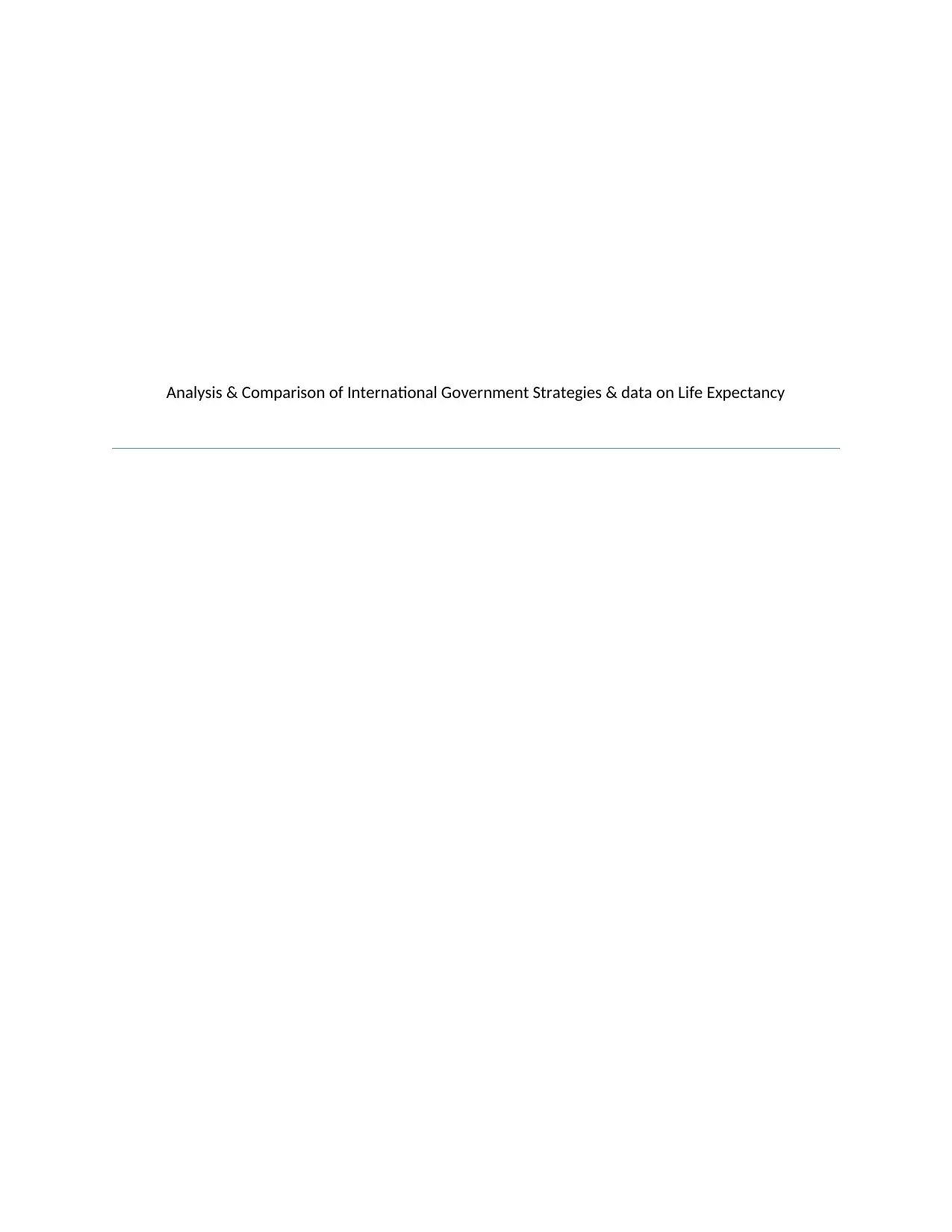
Analysis & Comparison of International Government Strategies & data on Life Expectancy
Paraphrase This Document
Need a fresh take? Get an instant paraphrase of this document with our AI Paraphraser
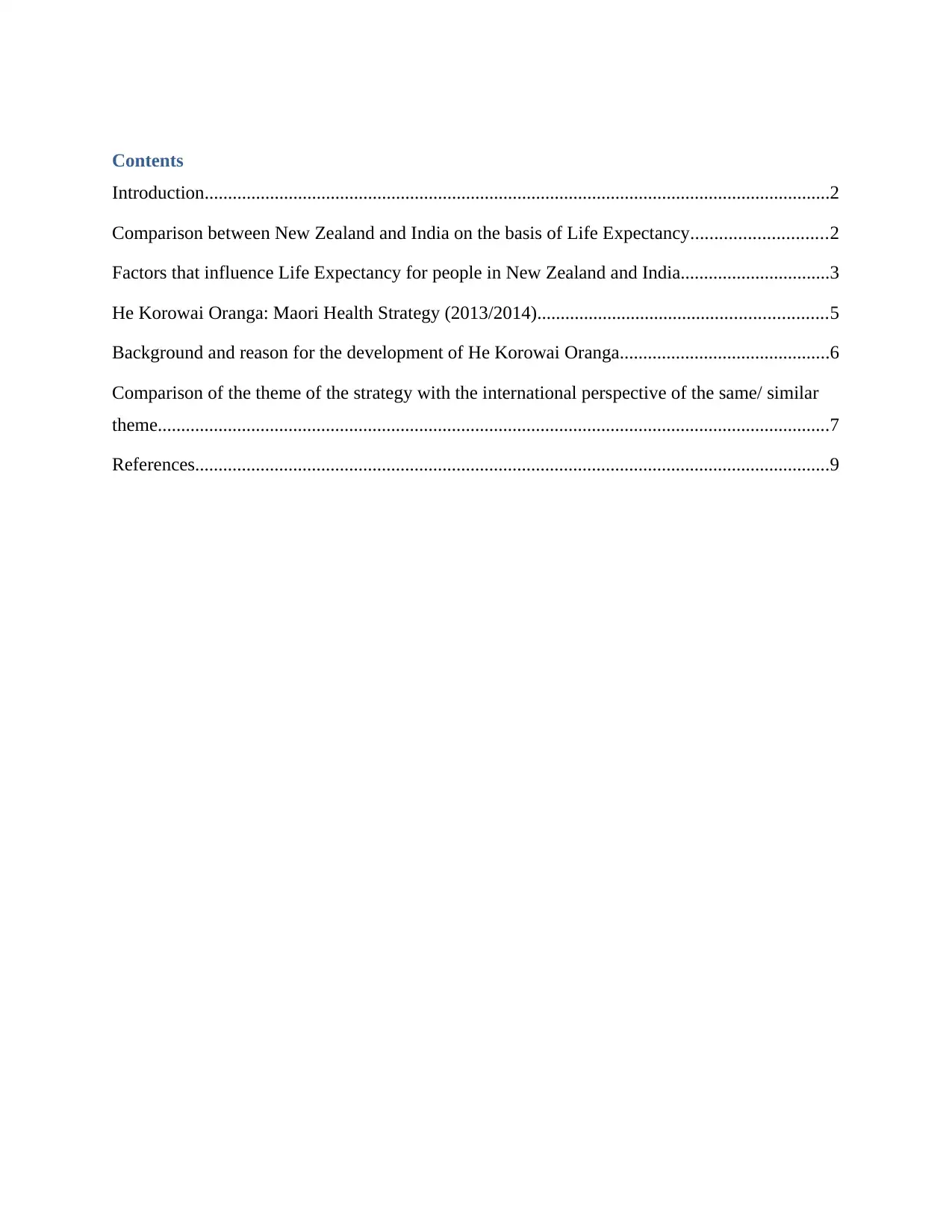
Contents
Introduction......................................................................................................................................2
Comparison between New Zealand and India on the basis of Life Expectancy.............................2
Factors that influence Life Expectancy for people in New Zealand and India................................3
He Korowai Oranga: Maori Health Strategy (2013/2014)..............................................................5
Background and reason for the development of He Korowai Oranga.............................................6
Comparison of the theme of the strategy with the international perspective of the same/ similar
theme................................................................................................................................................7
References........................................................................................................................................9
Introduction......................................................................................................................................2
Comparison between New Zealand and India on the basis of Life Expectancy.............................2
Factors that influence Life Expectancy for people in New Zealand and India................................3
He Korowai Oranga: Maori Health Strategy (2013/2014)..............................................................5
Background and reason for the development of He Korowai Oranga.............................................6
Comparison of the theme of the strategy with the international perspective of the same/ similar
theme................................................................................................................................................7
References........................................................................................................................................9
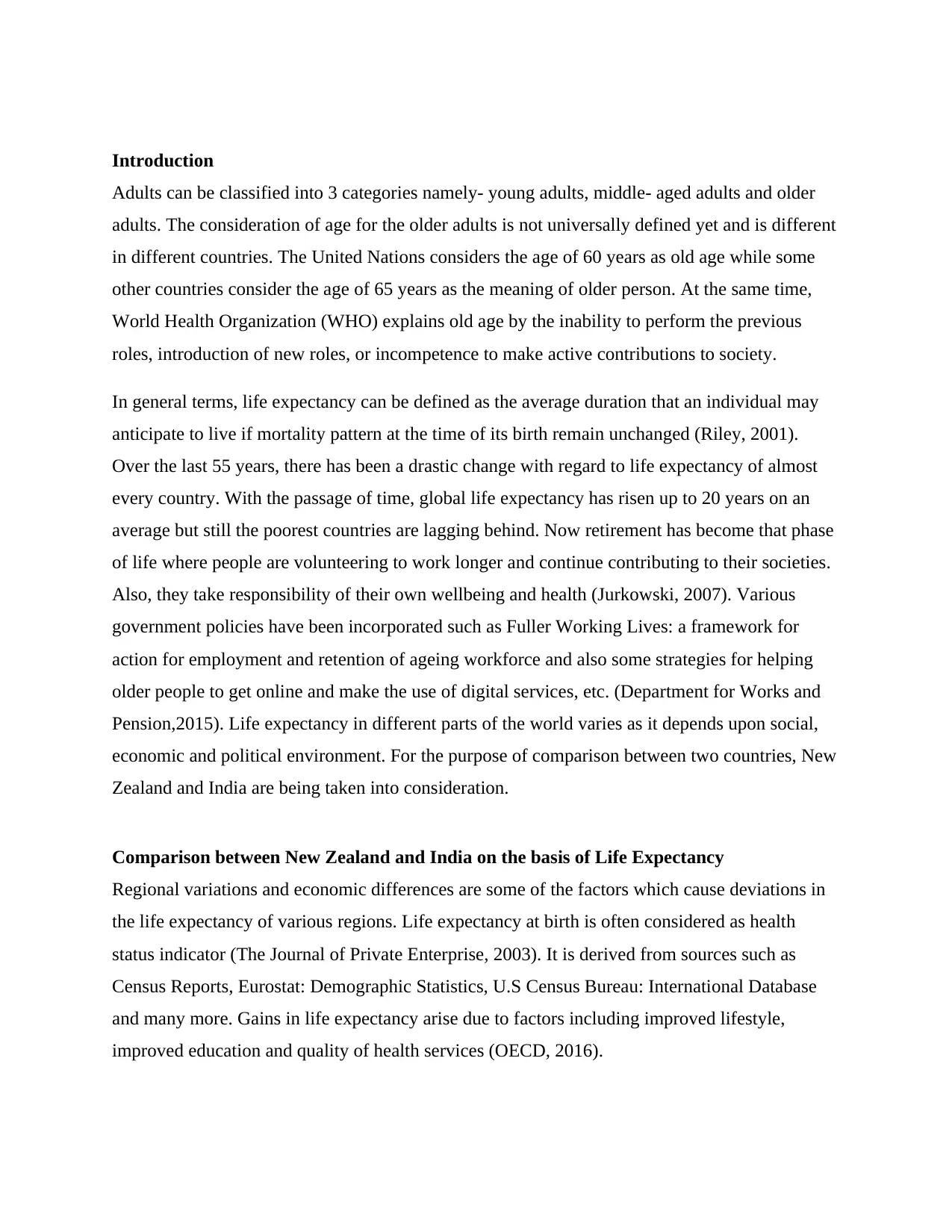
Introduction
Adults can be classified into 3 categories namely- young adults, middle- aged adults and older
adults. The consideration of age for the older adults is not universally defined yet and is different
in different countries. The United Nations considers the age of 60 years as old age while some
other countries consider the age of 65 years as the meaning of older person. At the same time,
World Health Organization (WHO) explains old age by the inability to perform the previous
roles, introduction of new roles, or incompetence to make active contributions to society.
In general terms, life expectancy can be defined as the average duration that an individual may
anticipate to live if mortality pattern at the time of its birth remain unchanged (Riley, 2001).
Over the last 55 years, there has been a drastic change with regard to life expectancy of almost
every country. With the passage of time, global life expectancy has risen up to 20 years on an
average but still the poorest countries are lagging behind. Now retirement has become that phase
of life where people are volunteering to work longer and continue contributing to their societies.
Also, they take responsibility of their own wellbeing and health (Jurkowski, 2007). Various
government policies have been incorporated such as Fuller Working Lives: a framework for
action for employment and retention of ageing workforce and also some strategies for helping
older people to get online and make the use of digital services, etc. (Department for Works and
Pension,2015). Life expectancy in different parts of the world varies as it depends upon social,
economic and political environment. For the purpose of comparison between two countries, New
Zealand and India are being taken into consideration.
Comparison between New Zealand and India on the basis of Life Expectancy
Regional variations and economic differences are some of the factors which cause deviations in
the life expectancy of various regions. Life expectancy at birth is often considered as health
status indicator (The Journal of Private Enterprise, 2003). It is derived from sources such as
Census Reports, Eurostat: Demographic Statistics, U.S Census Bureau: International Database
and many more. Gains in life expectancy arise due to factors including improved lifestyle,
improved education and quality of health services (OECD, 2016).
Adults can be classified into 3 categories namely- young adults, middle- aged adults and older
adults. The consideration of age for the older adults is not universally defined yet and is different
in different countries. The United Nations considers the age of 60 years as old age while some
other countries consider the age of 65 years as the meaning of older person. At the same time,
World Health Organization (WHO) explains old age by the inability to perform the previous
roles, introduction of new roles, or incompetence to make active contributions to society.
In general terms, life expectancy can be defined as the average duration that an individual may
anticipate to live if mortality pattern at the time of its birth remain unchanged (Riley, 2001).
Over the last 55 years, there has been a drastic change with regard to life expectancy of almost
every country. With the passage of time, global life expectancy has risen up to 20 years on an
average but still the poorest countries are lagging behind. Now retirement has become that phase
of life where people are volunteering to work longer and continue contributing to their societies.
Also, they take responsibility of their own wellbeing and health (Jurkowski, 2007). Various
government policies have been incorporated such as Fuller Working Lives: a framework for
action for employment and retention of ageing workforce and also some strategies for helping
older people to get online and make the use of digital services, etc. (Department for Works and
Pension,2015). Life expectancy in different parts of the world varies as it depends upon social,
economic and political environment. For the purpose of comparison between two countries, New
Zealand and India are being taken into consideration.
Comparison between New Zealand and India on the basis of Life Expectancy
Regional variations and economic differences are some of the factors which cause deviations in
the life expectancy of various regions. Life expectancy at birth is often considered as health
status indicator (The Journal of Private Enterprise, 2003). It is derived from sources such as
Census Reports, Eurostat: Demographic Statistics, U.S Census Bureau: International Database
and many more. Gains in life expectancy arise due to factors including improved lifestyle,
improved education and quality of health services (OECD, 2016).
⊘ This is a preview!⊘
Do you want full access?
Subscribe today to unlock all pages.

Trusted by 1+ million students worldwide
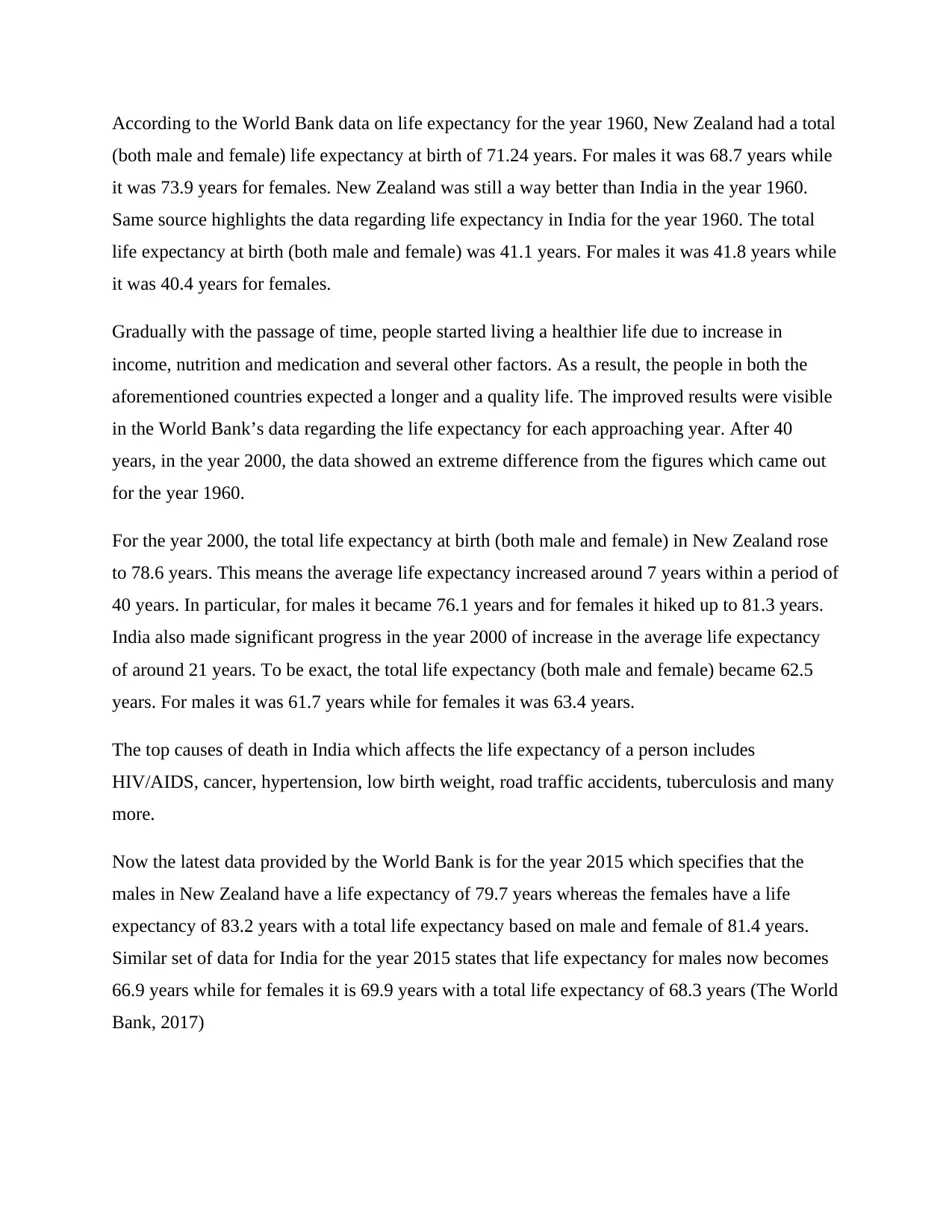
According to the World Bank data on life expectancy for the year 1960, New Zealand had a total
(both male and female) life expectancy at birth of 71.24 years. For males it was 68.7 years while
it was 73.9 years for females. New Zealand was still a way better than India in the year 1960.
Same source highlights the data regarding life expectancy in India for the year 1960. The total
life expectancy at birth (both male and female) was 41.1 years. For males it was 41.8 years while
it was 40.4 years for females.
Gradually with the passage of time, people started living a healthier life due to increase in
income, nutrition and medication and several other factors. As a result, the people in both the
aforementioned countries expected a longer and a quality life. The improved results were visible
in the World Bank’s data regarding the life expectancy for each approaching year. After 40
years, in the year 2000, the data showed an extreme difference from the figures which came out
for the year 1960.
For the year 2000, the total life expectancy at birth (both male and female) in New Zealand rose
to 78.6 years. This means the average life expectancy increased around 7 years within a period of
40 years. In particular, for males it became 76.1 years and for females it hiked up to 81.3 years.
India also made significant progress in the year 2000 of increase in the average life expectancy
of around 21 years. To be exact, the total life expectancy (both male and female) became 62.5
years. For males it was 61.7 years while for females it was 63.4 years.
The top causes of death in India which affects the life expectancy of a person includes
HIV/AIDS, cancer, hypertension, low birth weight, road traffic accidents, tuberculosis and many
more.
Now the latest data provided by the World Bank is for the year 2015 which specifies that the
males in New Zealand have a life expectancy of 79.7 years whereas the females have a life
expectancy of 83.2 years with a total life expectancy based on male and female of 81.4 years.
Similar set of data for India for the year 2015 states that life expectancy for males now becomes
66.9 years while for females it is 69.9 years with a total life expectancy of 68.3 years (The World
Bank, 2017)
(both male and female) life expectancy at birth of 71.24 years. For males it was 68.7 years while
it was 73.9 years for females. New Zealand was still a way better than India in the year 1960.
Same source highlights the data regarding life expectancy in India for the year 1960. The total
life expectancy at birth (both male and female) was 41.1 years. For males it was 41.8 years while
it was 40.4 years for females.
Gradually with the passage of time, people started living a healthier life due to increase in
income, nutrition and medication and several other factors. As a result, the people in both the
aforementioned countries expected a longer and a quality life. The improved results were visible
in the World Bank’s data regarding the life expectancy for each approaching year. After 40
years, in the year 2000, the data showed an extreme difference from the figures which came out
for the year 1960.
For the year 2000, the total life expectancy at birth (both male and female) in New Zealand rose
to 78.6 years. This means the average life expectancy increased around 7 years within a period of
40 years. In particular, for males it became 76.1 years and for females it hiked up to 81.3 years.
India also made significant progress in the year 2000 of increase in the average life expectancy
of around 21 years. To be exact, the total life expectancy (both male and female) became 62.5
years. For males it was 61.7 years while for females it was 63.4 years.
The top causes of death in India which affects the life expectancy of a person includes
HIV/AIDS, cancer, hypertension, low birth weight, road traffic accidents, tuberculosis and many
more.
Now the latest data provided by the World Bank is for the year 2015 which specifies that the
males in New Zealand have a life expectancy of 79.7 years whereas the females have a life
expectancy of 83.2 years with a total life expectancy based on male and female of 81.4 years.
Similar set of data for India for the year 2015 states that life expectancy for males now becomes
66.9 years while for females it is 69.9 years with a total life expectancy of 68.3 years (The World
Bank, 2017)
Paraphrase This Document
Need a fresh take? Get an instant paraphrase of this document with our AI Paraphraser
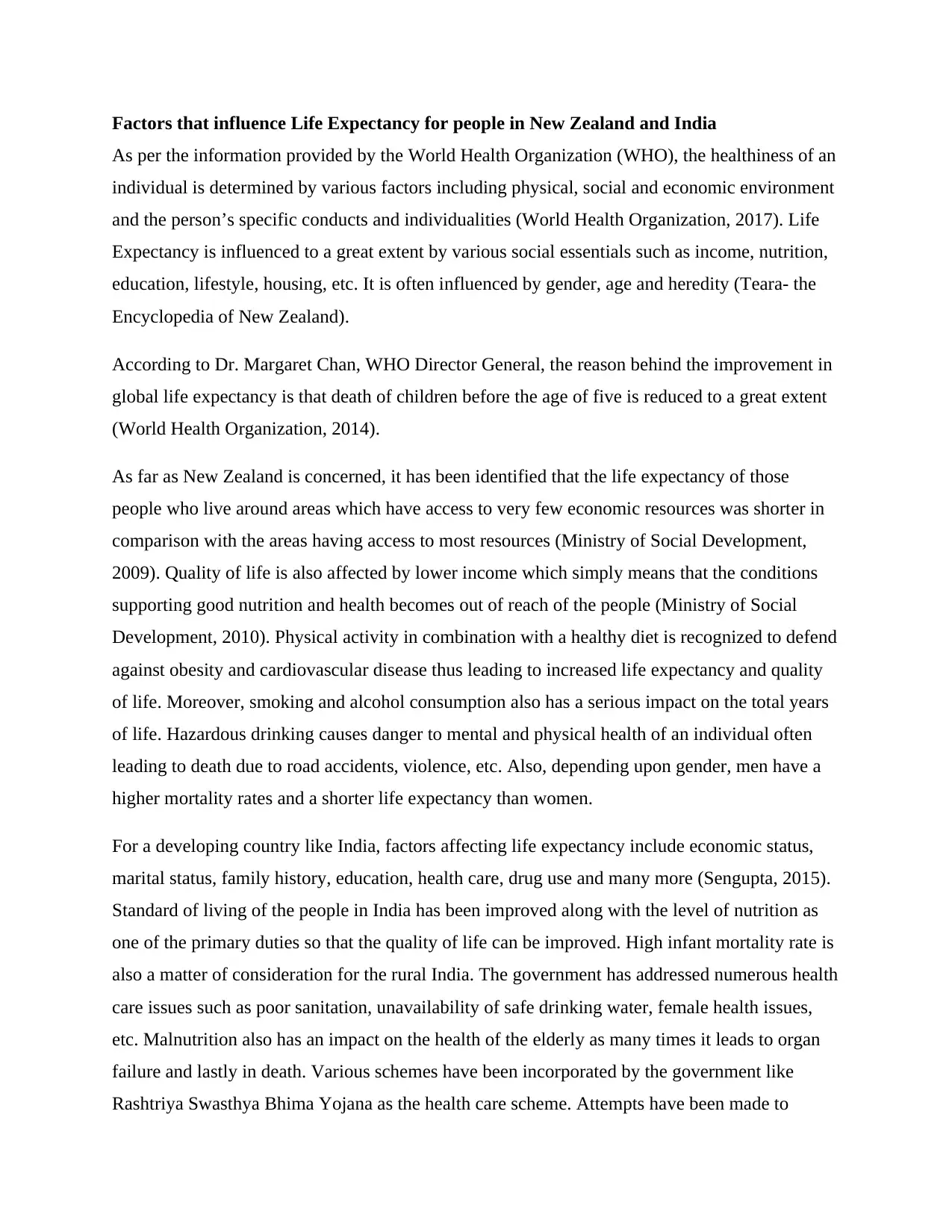
Factors that influence Life Expectancy for people in New Zealand and India
As per the information provided by the World Health Organization (WHO), the healthiness of an
individual is determined by various factors including physical, social and economic environment
and the person’s specific conducts and individualities (World Health Organization, 2017). Life
Expectancy is influenced to a great extent by various social essentials such as income, nutrition,
education, lifestyle, housing, etc. It is often influenced by gender, age and heredity (Teara- the
Encyclopedia of New Zealand).
According to Dr. Margaret Chan, WHO Director General, the reason behind the improvement in
global life expectancy is that death of children before the age of five is reduced to a great extent
(World Health Organization, 2014).
As far as New Zealand is concerned, it has been identified that the life expectancy of those
people who live around areas which have access to very few economic resources was shorter in
comparison with the areas having access to most resources (Ministry of Social Development,
2009). Quality of life is also affected by lower income which simply means that the conditions
supporting good nutrition and health becomes out of reach of the people (Ministry of Social
Development, 2010). Physical activity in combination with a healthy diet is recognized to defend
against obesity and cardiovascular disease thus leading to increased life expectancy and quality
of life. Moreover, smoking and alcohol consumption also has a serious impact on the total years
of life. Hazardous drinking causes danger to mental and physical health of an individual often
leading to death due to road accidents, violence, etc. Also, depending upon gender, men have a
higher mortality rates and a shorter life expectancy than women.
For a developing country like India, factors affecting life expectancy include economic status,
marital status, family history, education, health care, drug use and many more (Sengupta, 2015).
Standard of living of the people in India has been improved along with the level of nutrition as
one of the primary duties so that the quality of life can be improved. High infant mortality rate is
also a matter of consideration for the rural India. The government has addressed numerous health
care issues such as poor sanitation, unavailability of safe drinking water, female health issues,
etc. Malnutrition also has an impact on the health of the elderly as many times it leads to organ
failure and lastly in death. Various schemes have been incorporated by the government like
Rashtriya Swasthya Bhima Yojana as the health care scheme. Attempts have been made to
As per the information provided by the World Health Organization (WHO), the healthiness of an
individual is determined by various factors including physical, social and economic environment
and the person’s specific conducts and individualities (World Health Organization, 2017). Life
Expectancy is influenced to a great extent by various social essentials such as income, nutrition,
education, lifestyle, housing, etc. It is often influenced by gender, age and heredity (Teara- the
Encyclopedia of New Zealand).
According to Dr. Margaret Chan, WHO Director General, the reason behind the improvement in
global life expectancy is that death of children before the age of five is reduced to a great extent
(World Health Organization, 2014).
As far as New Zealand is concerned, it has been identified that the life expectancy of those
people who live around areas which have access to very few economic resources was shorter in
comparison with the areas having access to most resources (Ministry of Social Development,
2009). Quality of life is also affected by lower income which simply means that the conditions
supporting good nutrition and health becomes out of reach of the people (Ministry of Social
Development, 2010). Physical activity in combination with a healthy diet is recognized to defend
against obesity and cardiovascular disease thus leading to increased life expectancy and quality
of life. Moreover, smoking and alcohol consumption also has a serious impact on the total years
of life. Hazardous drinking causes danger to mental and physical health of an individual often
leading to death due to road accidents, violence, etc. Also, depending upon gender, men have a
higher mortality rates and a shorter life expectancy than women.
For a developing country like India, factors affecting life expectancy include economic status,
marital status, family history, education, health care, drug use and many more (Sengupta, 2015).
Standard of living of the people in India has been improved along with the level of nutrition as
one of the primary duties so that the quality of life can be improved. High infant mortality rate is
also a matter of consideration for the rural India. The government has addressed numerous health
care issues such as poor sanitation, unavailability of safe drinking water, female health issues,
etc. Malnutrition also has an impact on the health of the elderly as many times it leads to organ
failure and lastly in death. Various schemes have been incorporated by the government like
Rashtriya Swasthya Bhima Yojana as the health care scheme. Attempts have been made to
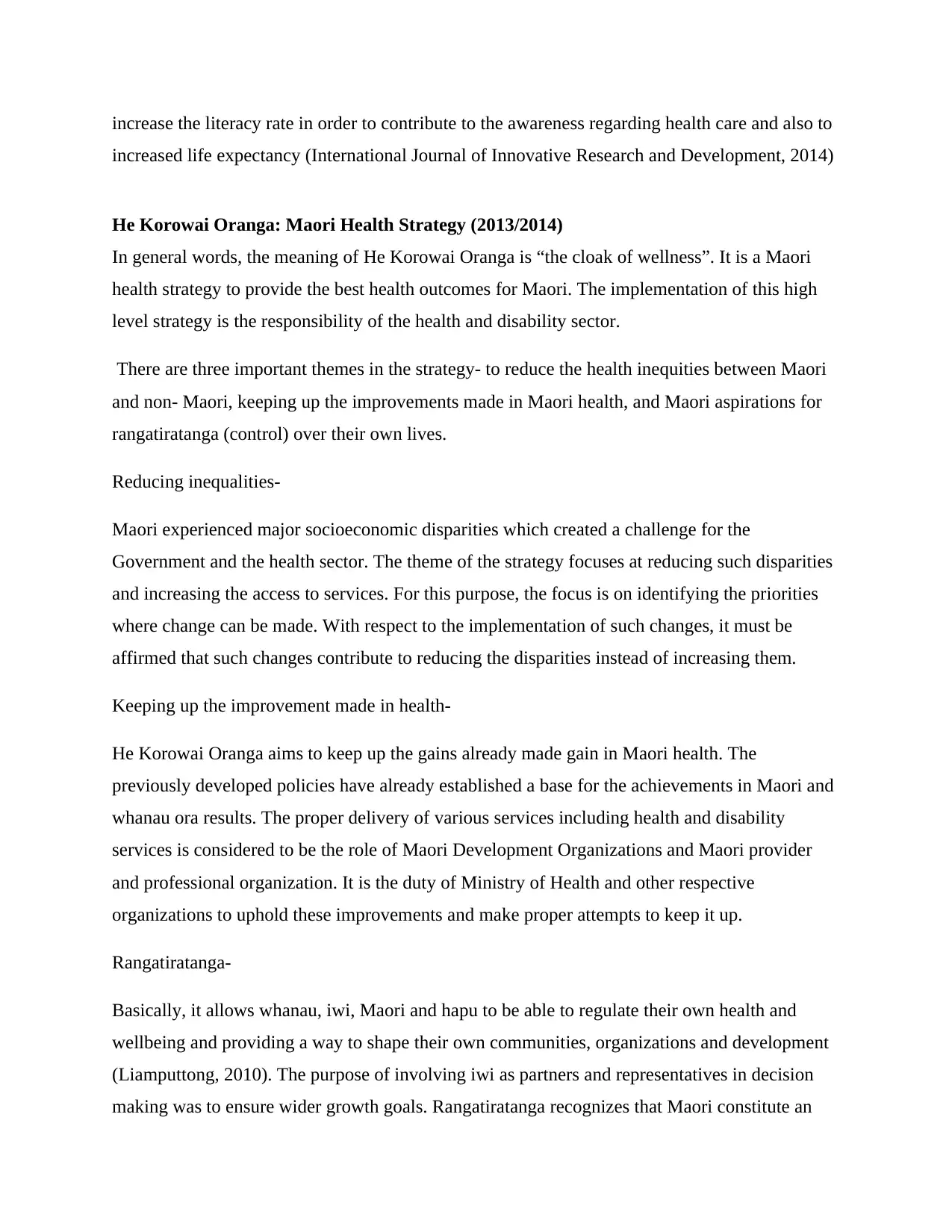
increase the literacy rate in order to contribute to the awareness regarding health care and also to
increased life expectancy (International Journal of Innovative Research and Development, 2014)
He Korowai Oranga: Maori Health Strategy (2013/2014)
In general words, the meaning of He Korowai Oranga is “the cloak of wellness”. It is a Maori
health strategy to provide the best health outcomes for Maori. The implementation of this high
level strategy is the responsibility of the health and disability sector.
There are three important themes in the strategy- to reduce the health inequities between Maori
and non- Maori, keeping up the improvements made in Maori health, and Maori aspirations for
rangatiratanga (control) over their own lives.
Reducing inequalities-
Maori experienced major socioeconomic disparities which created a challenge for the
Government and the health sector. The theme of the strategy focuses at reducing such disparities
and increasing the access to services. For this purpose, the focus is on identifying the priorities
where change can be made. With respect to the implementation of such changes, it must be
affirmed that such changes contribute to reducing the disparities instead of increasing them.
Keeping up the improvement made in health-
He Korowai Oranga aims to keep up the gains already made gain in Maori health. The
previously developed policies have already established a base for the achievements in Maori and
whanau ora results. The proper delivery of various services including health and disability
services is considered to be the role of Maori Development Organizations and Maori provider
and professional organization. It is the duty of Ministry of Health and other respective
organizations to uphold these improvements and make proper attempts to keep it up.
Rangatiratanga-
Basically, it allows whanau, iwi, Maori and hapu to be able to regulate their own health and
wellbeing and providing a way to shape their own communities, organizations and development
(Liamputtong, 2010). The purpose of involving iwi as partners and representatives in decision
making was to ensure wider growth goals. Rangatiratanga recognizes that Maori constitute an
increased life expectancy (International Journal of Innovative Research and Development, 2014)
He Korowai Oranga: Maori Health Strategy (2013/2014)
In general words, the meaning of He Korowai Oranga is “the cloak of wellness”. It is a Maori
health strategy to provide the best health outcomes for Maori. The implementation of this high
level strategy is the responsibility of the health and disability sector.
There are three important themes in the strategy- to reduce the health inequities between Maori
and non- Maori, keeping up the improvements made in Maori health, and Maori aspirations for
rangatiratanga (control) over their own lives.
Reducing inequalities-
Maori experienced major socioeconomic disparities which created a challenge for the
Government and the health sector. The theme of the strategy focuses at reducing such disparities
and increasing the access to services. For this purpose, the focus is on identifying the priorities
where change can be made. With respect to the implementation of such changes, it must be
affirmed that such changes contribute to reducing the disparities instead of increasing them.
Keeping up the improvement made in health-
He Korowai Oranga aims to keep up the gains already made gain in Maori health. The
previously developed policies have already established a base for the achievements in Maori and
whanau ora results. The proper delivery of various services including health and disability
services is considered to be the role of Maori Development Organizations and Maori provider
and professional organization. It is the duty of Ministry of Health and other respective
organizations to uphold these improvements and make proper attempts to keep it up.
Rangatiratanga-
Basically, it allows whanau, iwi, Maori and hapu to be able to regulate their own health and
wellbeing and providing a way to shape their own communities, organizations and development
(Liamputtong, 2010). The purpose of involving iwi as partners and representatives in decision
making was to ensure wider growth goals. Rangatiratanga recognizes that Maori constitute an
⊘ This is a preview!⊘
Do you want full access?
Subscribe today to unlock all pages.

Trusted by 1+ million students worldwide
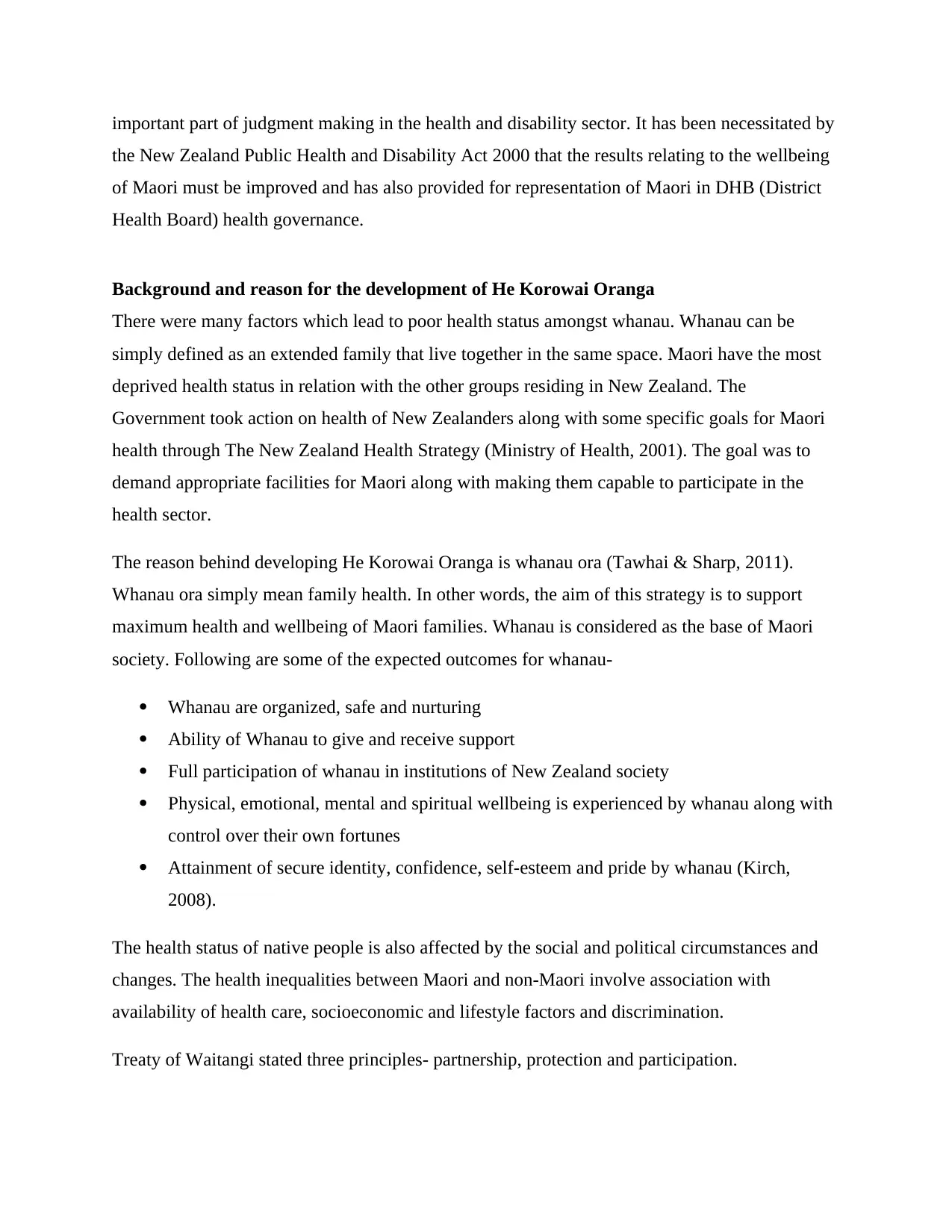
important part of judgment making in the health and disability sector. It has been necessitated by
the New Zealand Public Health and Disability Act 2000 that the results relating to the wellbeing
of Maori must be improved and has also provided for representation of Maori in DHB (District
Health Board) health governance.
Background and reason for the development of He Korowai Oranga
There were many factors which lead to poor health status amongst whanau. Whanau can be
simply defined as an extended family that live together in the same space. Maori have the most
deprived health status in relation with the other groups residing in New Zealand. The
Government took action on health of New Zealanders along with some specific goals for Maori
health through The New Zealand Health Strategy (Ministry of Health, 2001). The goal was to
demand appropriate facilities for Maori along with making them capable to participate in the
health sector.
The reason behind developing He Korowai Oranga is whanau ora (Tawhai & Sharp, 2011).
Whanau ora simply mean family health. In other words, the aim of this strategy is to support
maximum health and wellbeing of Maori families. Whanau is considered as the base of Maori
society. Following are some of the expected outcomes for whanau-
Whanau are organized, safe and nurturing
Ability of Whanau to give and receive support
Full participation of whanau in institutions of New Zealand society
Physical, emotional, mental and spiritual wellbeing is experienced by whanau along with
control over their own fortunes
Attainment of secure identity, confidence, self-esteem and pride by whanau (Kirch,
2008).
The health status of native people is also affected by the social and political circumstances and
changes. The health inequalities between Maori and non-Maori involve association with
availability of health care, socioeconomic and lifestyle factors and discrimination.
Treaty of Waitangi stated three principles- partnership, protection and participation.
the New Zealand Public Health and Disability Act 2000 that the results relating to the wellbeing
of Maori must be improved and has also provided for representation of Maori in DHB (District
Health Board) health governance.
Background and reason for the development of He Korowai Oranga
There were many factors which lead to poor health status amongst whanau. Whanau can be
simply defined as an extended family that live together in the same space. Maori have the most
deprived health status in relation with the other groups residing in New Zealand. The
Government took action on health of New Zealanders along with some specific goals for Maori
health through The New Zealand Health Strategy (Ministry of Health, 2001). The goal was to
demand appropriate facilities for Maori along with making them capable to participate in the
health sector.
The reason behind developing He Korowai Oranga is whanau ora (Tawhai & Sharp, 2011).
Whanau ora simply mean family health. In other words, the aim of this strategy is to support
maximum health and wellbeing of Maori families. Whanau is considered as the base of Maori
society. Following are some of the expected outcomes for whanau-
Whanau are organized, safe and nurturing
Ability of Whanau to give and receive support
Full participation of whanau in institutions of New Zealand society
Physical, emotional, mental and spiritual wellbeing is experienced by whanau along with
control over their own fortunes
Attainment of secure identity, confidence, self-esteem and pride by whanau (Kirch,
2008).
The health status of native people is also affected by the social and political circumstances and
changes. The health inequalities between Maori and non-Maori involve association with
availability of health care, socioeconomic and lifestyle factors and discrimination.
Treaty of Waitangi stated three principles- partnership, protection and participation.
Paraphrase This Document
Need a fresh take? Get an instant paraphrase of this document with our AI Paraphraser
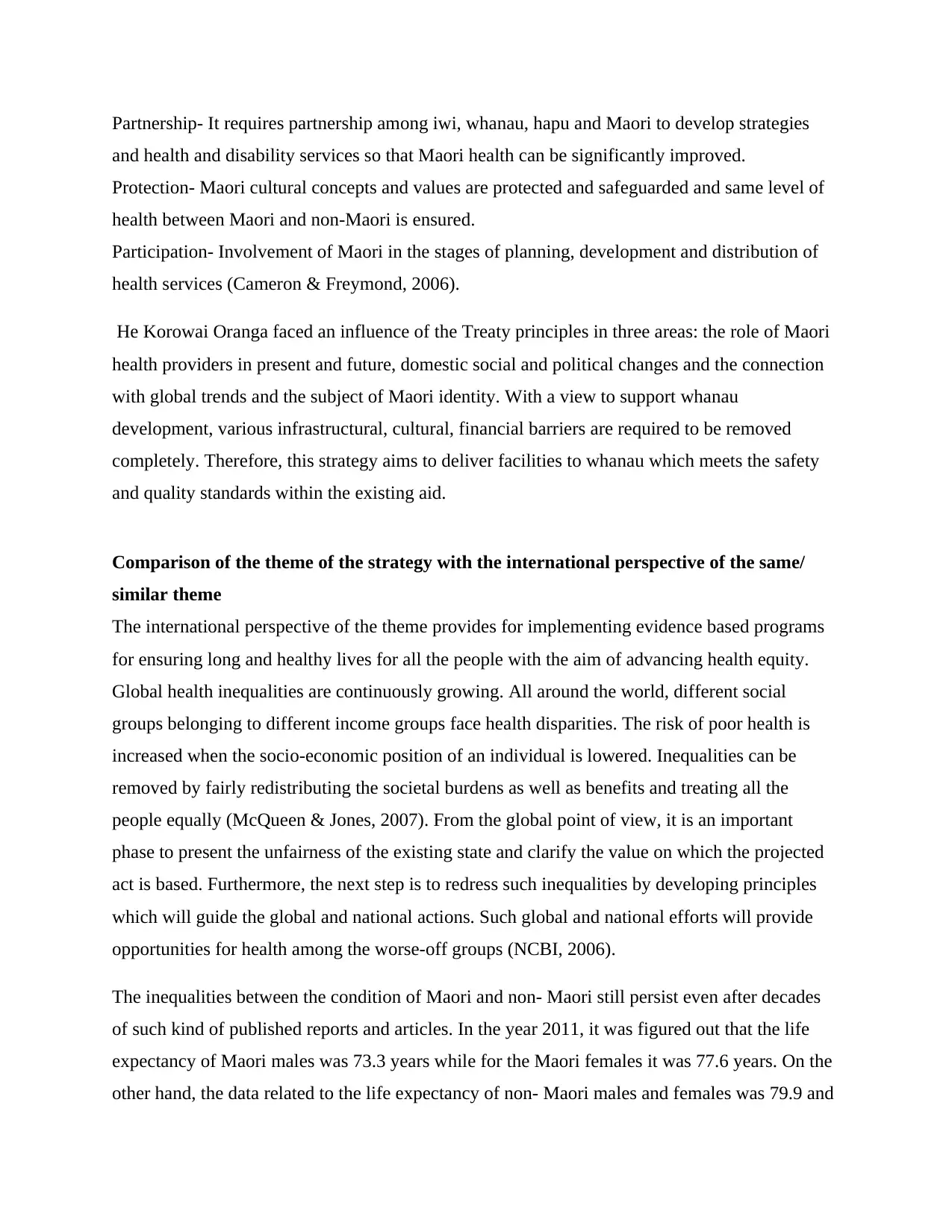
Partnership- It requires partnership among iwi, whanau, hapu and Maori to develop strategies
and health and disability services so that Maori health can be significantly improved.
Protection- Maori cultural concepts and values are protected and safeguarded and same level of
health between Maori and non-Maori is ensured.
Participation- Involvement of Maori in the stages of planning, development and distribution of
health services (Cameron & Freymond, 2006).
He Korowai Oranga faced an influence of the Treaty principles in three areas: the role of Maori
health providers in present and future, domestic social and political changes and the connection
with global trends and the subject of Maori identity. With a view to support whanau
development, various infrastructural, cultural, financial barriers are required to be removed
completely. Therefore, this strategy aims to deliver facilities to whanau which meets the safety
and quality standards within the existing aid.
Comparison of the theme of the strategy with the international perspective of the same/
similar theme
The international perspective of the theme provides for implementing evidence based programs
for ensuring long and healthy lives for all the people with the aim of advancing health equity.
Global health inequalities are continuously growing. All around the world, different social
groups belonging to different income groups face health disparities. The risk of poor health is
increased when the socio-economic position of an individual is lowered. Inequalities can be
removed by fairly redistributing the societal burdens as well as benefits and treating all the
people equally (McQueen & Jones, 2007). From the global point of view, it is an important
phase to present the unfairness of the existing state and clarify the value on which the projected
act is based. Furthermore, the next step is to redress such inequalities by developing principles
which will guide the global and national actions. Such global and national efforts will provide
opportunities for health among the worse-off groups (NCBI, 2006).
The inequalities between the condition of Maori and non- Maori still persist even after decades
of such kind of published reports and articles. In the year 2011, it was figured out that the life
expectancy of Maori males was 73.3 years while for the Maori females it was 77.6 years. On the
other hand, the data related to the life expectancy of non- Maori males and females was 79.9 and
and health and disability services so that Maori health can be significantly improved.
Protection- Maori cultural concepts and values are protected and safeguarded and same level of
health between Maori and non-Maori is ensured.
Participation- Involvement of Maori in the stages of planning, development and distribution of
health services (Cameron & Freymond, 2006).
He Korowai Oranga faced an influence of the Treaty principles in three areas: the role of Maori
health providers in present and future, domestic social and political changes and the connection
with global trends and the subject of Maori identity. With a view to support whanau
development, various infrastructural, cultural, financial barriers are required to be removed
completely. Therefore, this strategy aims to deliver facilities to whanau which meets the safety
and quality standards within the existing aid.
Comparison of the theme of the strategy with the international perspective of the same/
similar theme
The international perspective of the theme provides for implementing evidence based programs
for ensuring long and healthy lives for all the people with the aim of advancing health equity.
Global health inequalities are continuously growing. All around the world, different social
groups belonging to different income groups face health disparities. The risk of poor health is
increased when the socio-economic position of an individual is lowered. Inequalities can be
removed by fairly redistributing the societal burdens as well as benefits and treating all the
people equally (McQueen & Jones, 2007). From the global point of view, it is an important
phase to present the unfairness of the existing state and clarify the value on which the projected
act is based. Furthermore, the next step is to redress such inequalities by developing principles
which will guide the global and national actions. Such global and national efforts will provide
opportunities for health among the worse-off groups (NCBI, 2006).
The inequalities between the condition of Maori and non- Maori still persist even after decades
of such kind of published reports and articles. In the year 2011, it was figured out that the life
expectancy of Maori males was 73.3 years while for the Maori females it was 77.6 years. On the
other hand, the data related to the life expectancy of non- Maori males and females was 79.9 and
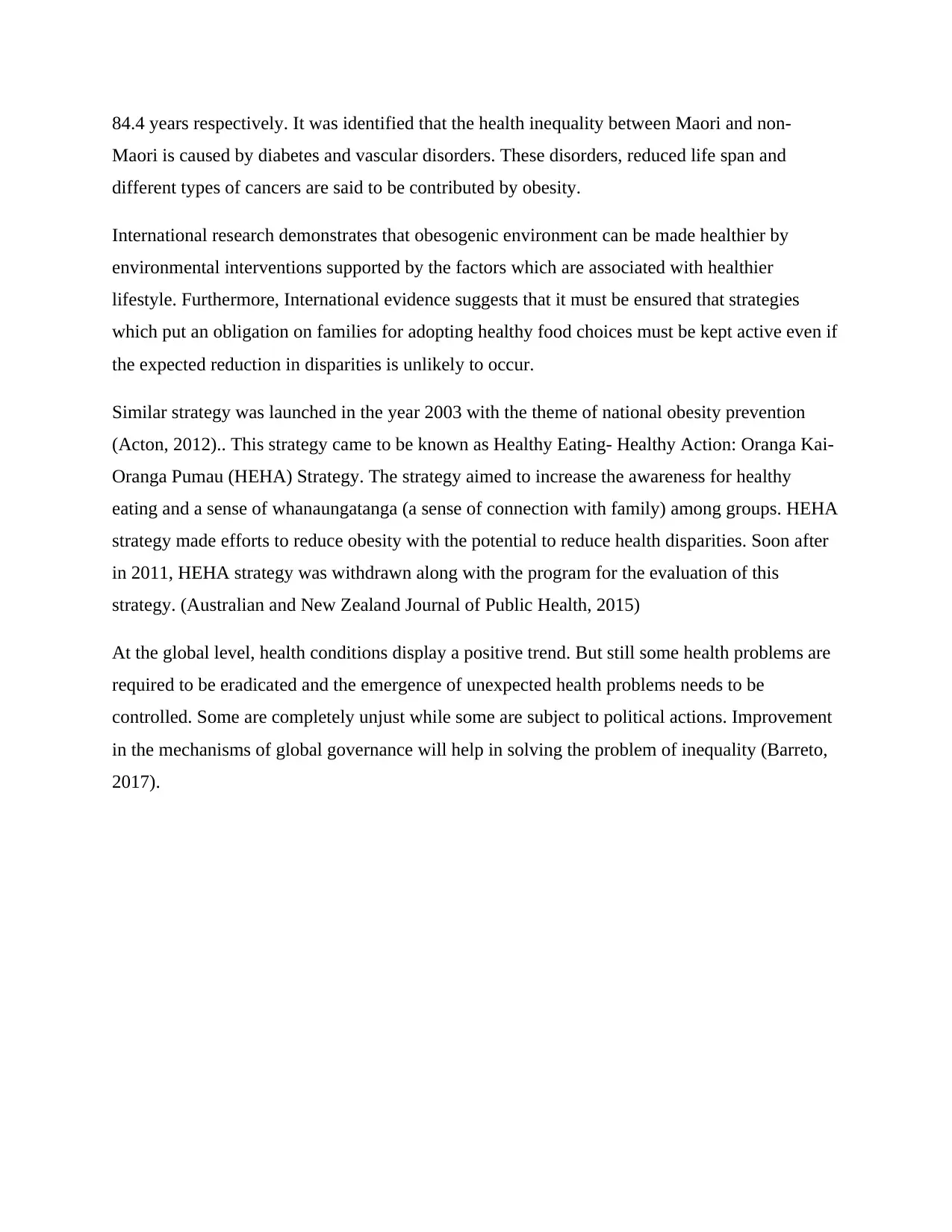
84.4 years respectively. It was identified that the health inequality between Maori and non-
Maori is caused by diabetes and vascular disorders. These disorders, reduced life span and
different types of cancers are said to be contributed by obesity.
International research demonstrates that obesogenic environment can be made healthier by
environmental interventions supported by the factors which are associated with healthier
lifestyle. Furthermore, International evidence suggests that it must be ensured that strategies
which put an obligation on families for adopting healthy food choices must be kept active even if
the expected reduction in disparities is unlikely to occur.
Similar strategy was launched in the year 2003 with the theme of national obesity prevention
(Acton, 2012).. This strategy came to be known as Healthy Eating- Healthy Action: Oranga Kai-
Oranga Pumau (HEHA) Strategy. The strategy aimed to increase the awareness for healthy
eating and a sense of whanaungatanga (a sense of connection with family) among groups. HEHA
strategy made efforts to reduce obesity with the potential to reduce health disparities. Soon after
in 2011, HEHA strategy was withdrawn along with the program for the evaluation of this
strategy. (Australian and New Zealand Journal of Public Health, 2015)
At the global level, health conditions display a positive trend. But still some health problems are
required to be eradicated and the emergence of unexpected health problems needs to be
controlled. Some are completely unjust while some are subject to political actions. Improvement
in the mechanisms of global governance will help in solving the problem of inequality (Barreto,
2017).
Maori is caused by diabetes and vascular disorders. These disorders, reduced life span and
different types of cancers are said to be contributed by obesity.
International research demonstrates that obesogenic environment can be made healthier by
environmental interventions supported by the factors which are associated with healthier
lifestyle. Furthermore, International evidence suggests that it must be ensured that strategies
which put an obligation on families for adopting healthy food choices must be kept active even if
the expected reduction in disparities is unlikely to occur.
Similar strategy was launched in the year 2003 with the theme of national obesity prevention
(Acton, 2012).. This strategy came to be known as Healthy Eating- Healthy Action: Oranga Kai-
Oranga Pumau (HEHA) Strategy. The strategy aimed to increase the awareness for healthy
eating and a sense of whanaungatanga (a sense of connection with family) among groups. HEHA
strategy made efforts to reduce obesity with the potential to reduce health disparities. Soon after
in 2011, HEHA strategy was withdrawn along with the program for the evaluation of this
strategy. (Australian and New Zealand Journal of Public Health, 2015)
At the global level, health conditions display a positive trend. But still some health problems are
required to be eradicated and the emergence of unexpected health problems needs to be
controlled. Some are completely unjust while some are subject to political actions. Improvement
in the mechanisms of global governance will help in solving the problem of inequality (Barreto,
2017).
⊘ This is a preview!⊘
Do you want full access?
Subscribe today to unlock all pages.

Trusted by 1+ million students worldwide
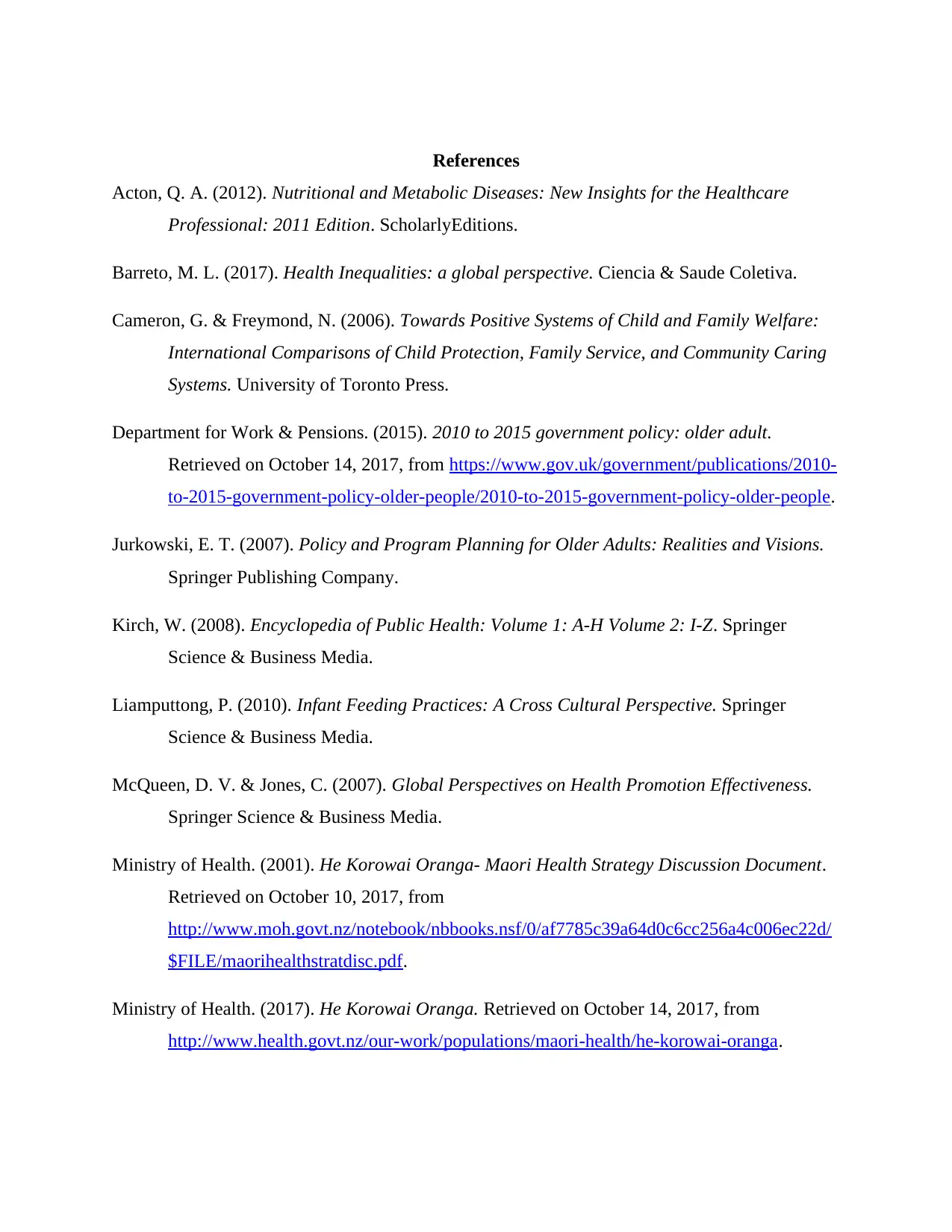
References
Acton, Q. A. (2012). Nutritional and Metabolic Diseases: New Insights for the Healthcare
Professional: 2011 Edition. ScholarlyEditions.
Barreto, M. L. (2017). Health Inequalities: a global perspective. Ciencia & Saude Coletiva.
Cameron, G. & Freymond, N. (2006). Towards Positive Systems of Child and Family Welfare:
International Comparisons of Child Protection, Family Service, and Community Caring
Systems. University of Toronto Press.
Department for Work & Pensions. (2015). 2010 to 2015 government policy: older adult.
Retrieved on October 14, 2017, from https://www.gov.uk/government/publications/2010-
to-2015-government-policy-older-people/2010-to-2015-government-policy-older-people.
Jurkowski, E. T. (2007). Policy and Program Planning for Older Adults: Realities and Visions.
Springer Publishing Company.
Kirch, W. (2008). Encyclopedia of Public Health: Volume 1: A-H Volume 2: I-Z. Springer
Science & Business Media.
Liamputtong, P. (2010). Infant Feeding Practices: A Cross Cultural Perspective. Springer
Science & Business Media.
McQueen, D. V. & Jones, C. (2007). Global Perspectives on Health Promotion Effectiveness.
Springer Science & Business Media.
Ministry of Health. (2001). He Korowai Oranga- Maori Health Strategy Discussion Document.
Retrieved on October 10, 2017, from
http://www.moh.govt.nz/notebook/nbbooks.nsf/0/af7785c39a64d0c6cc256a4c006ec22d/
$FILE/maorihealthstratdisc.pdf.
Ministry of Health. (2017). He Korowai Oranga. Retrieved on October 14, 2017, from
http://www.health.govt.nz/our-work/populations/maori-health/he-korowai-oranga.
Acton, Q. A. (2012). Nutritional and Metabolic Diseases: New Insights for the Healthcare
Professional: 2011 Edition. ScholarlyEditions.
Barreto, M. L. (2017). Health Inequalities: a global perspective. Ciencia & Saude Coletiva.
Cameron, G. & Freymond, N. (2006). Towards Positive Systems of Child and Family Welfare:
International Comparisons of Child Protection, Family Service, and Community Caring
Systems. University of Toronto Press.
Department for Work & Pensions. (2015). 2010 to 2015 government policy: older adult.
Retrieved on October 14, 2017, from https://www.gov.uk/government/publications/2010-
to-2015-government-policy-older-people/2010-to-2015-government-policy-older-people.
Jurkowski, E. T. (2007). Policy and Program Planning for Older Adults: Realities and Visions.
Springer Publishing Company.
Kirch, W. (2008). Encyclopedia of Public Health: Volume 1: A-H Volume 2: I-Z. Springer
Science & Business Media.
Liamputtong, P. (2010). Infant Feeding Practices: A Cross Cultural Perspective. Springer
Science & Business Media.
McQueen, D. V. & Jones, C. (2007). Global Perspectives on Health Promotion Effectiveness.
Springer Science & Business Media.
Ministry of Health. (2001). He Korowai Oranga- Maori Health Strategy Discussion Document.
Retrieved on October 10, 2017, from
http://www.moh.govt.nz/notebook/nbbooks.nsf/0/af7785c39a64d0c6cc256a4c006ec22d/
$FILE/maorihealthstratdisc.pdf.
Ministry of Health. (2017). He Korowai Oranga. Retrieved on October 14, 2017, from
http://www.health.govt.nz/our-work/populations/maori-health/he-korowai-oranga.
Paraphrase This Document
Need a fresh take? Get an instant paraphrase of this document with our AI Paraphraser
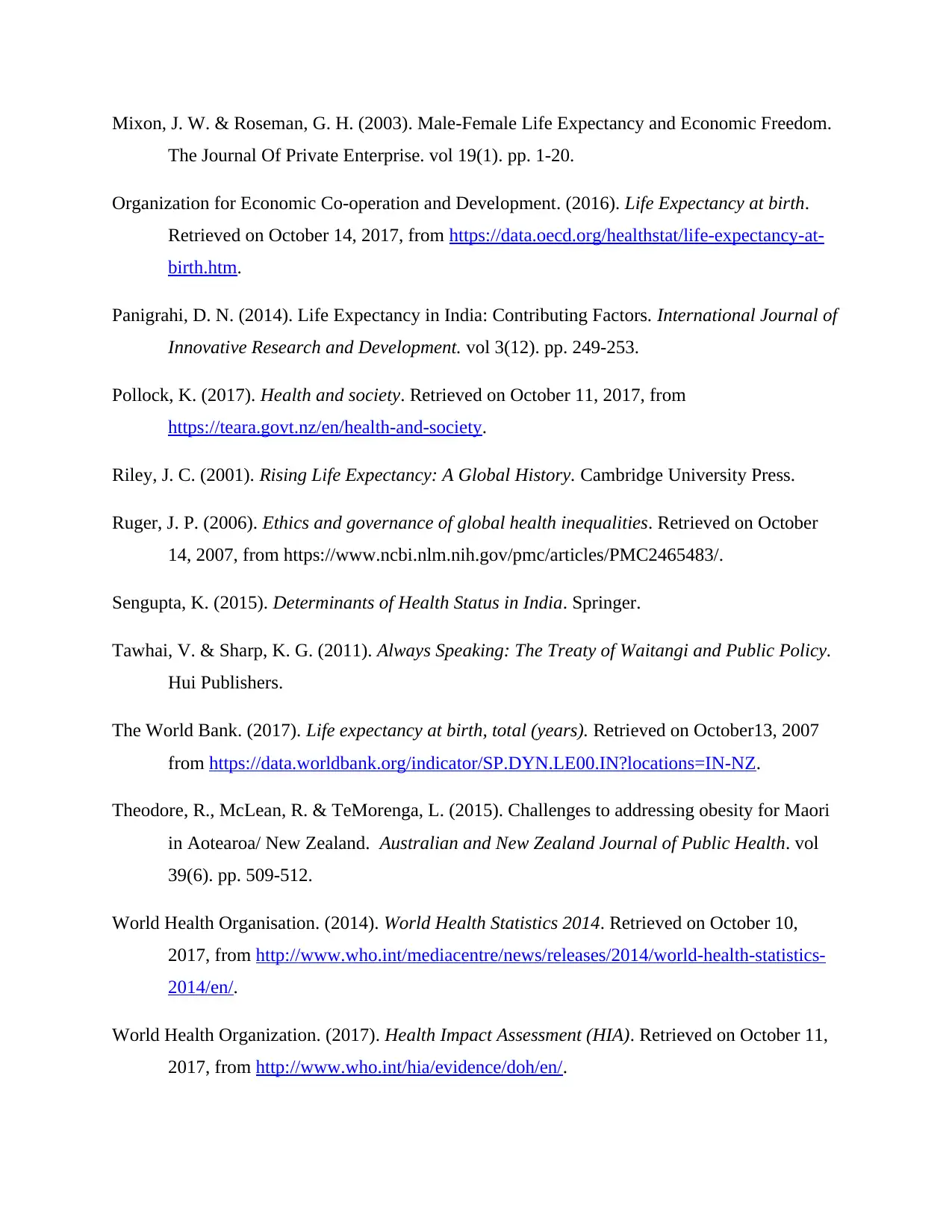
Mixon, J. W. & Roseman, G. H. (2003). Male-Female Life Expectancy and Economic Freedom.
The Journal Of Private Enterprise. vol 19(1). pp. 1-20.
Organization for Economic Co-operation and Development. (2016). Life Expectancy at birth.
Retrieved on October 14, 2017, from https://data.oecd.org/healthstat/life-expectancy-at-
birth.htm.
Panigrahi, D. N. (2014). Life Expectancy in India: Contributing Factors. International Journal of
Innovative Research and Development. vol 3(12). pp. 249-253.
Pollock, K. (2017). Health and society. Retrieved on October 11, 2017, from
https://teara.govt.nz/en/health-and-society.
Riley, J. C. (2001). Rising Life Expectancy: A Global History. Cambridge University Press.
Ruger, J. P. (2006). Ethics and governance of global health inequalities. Retrieved on October
14, 2007, from https://www.ncbi.nlm.nih.gov/pmc/articles/PMC2465483/.
Sengupta, K. (2015). Determinants of Health Status in India. Springer.
Tawhai, V. & Sharp, K. G. (2011). Always Speaking: The Treaty of Waitangi and Public Policy.
Hui Publishers.
The World Bank. (2017). Life expectancy at birth, total (years). Retrieved on October13, 2007
from https://data.worldbank.org/indicator/SP.DYN.LE00.IN?locations=IN-NZ.
Theodore, R., McLean, R. & TeMorenga, L. (2015). Challenges to addressing obesity for Maori
in Aotearoa/ New Zealand. Australian and New Zealand Journal of Public Health. vol
39(6). pp. 509-512.
World Health Organisation. (2014). World Health Statistics 2014. Retrieved on October 10,
2017, from http://www.who.int/mediacentre/news/releases/2014/world-health-statistics-
2014/en/.
World Health Organization. (2017). Health Impact Assessment (HIA). Retrieved on October 11,
2017, from http://www.who.int/hia/evidence/doh/en/.
The Journal Of Private Enterprise. vol 19(1). pp. 1-20.
Organization for Economic Co-operation and Development. (2016). Life Expectancy at birth.
Retrieved on October 14, 2017, from https://data.oecd.org/healthstat/life-expectancy-at-
birth.htm.
Panigrahi, D. N. (2014). Life Expectancy in India: Contributing Factors. International Journal of
Innovative Research and Development. vol 3(12). pp. 249-253.
Pollock, K. (2017). Health and society. Retrieved on October 11, 2017, from
https://teara.govt.nz/en/health-and-society.
Riley, J. C. (2001). Rising Life Expectancy: A Global History. Cambridge University Press.
Ruger, J. P. (2006). Ethics and governance of global health inequalities. Retrieved on October
14, 2007, from https://www.ncbi.nlm.nih.gov/pmc/articles/PMC2465483/.
Sengupta, K. (2015). Determinants of Health Status in India. Springer.
Tawhai, V. & Sharp, K. G. (2011). Always Speaking: The Treaty of Waitangi and Public Policy.
Hui Publishers.
The World Bank. (2017). Life expectancy at birth, total (years). Retrieved on October13, 2007
from https://data.worldbank.org/indicator/SP.DYN.LE00.IN?locations=IN-NZ.
Theodore, R., McLean, R. & TeMorenga, L. (2015). Challenges to addressing obesity for Maori
in Aotearoa/ New Zealand. Australian and New Zealand Journal of Public Health. vol
39(6). pp. 509-512.
World Health Organisation. (2014). World Health Statistics 2014. Retrieved on October 10,
2017, from http://www.who.int/mediacentre/news/releases/2014/world-health-statistics-
2014/en/.
World Health Organization. (2017). Health Impact Assessment (HIA). Retrieved on October 11,
2017, from http://www.who.int/hia/evidence/doh/en/.
1 out of 11
Related Documents
Your All-in-One AI-Powered Toolkit for Academic Success.
+13062052269
info@desklib.com
Available 24*7 on WhatsApp / Email
![[object Object]](/_next/static/media/star-bottom.7253800d.svg)
Unlock your academic potential
Copyright © 2020–2025 A2Z Services. All Rights Reserved. Developed and managed by ZUCOL.





